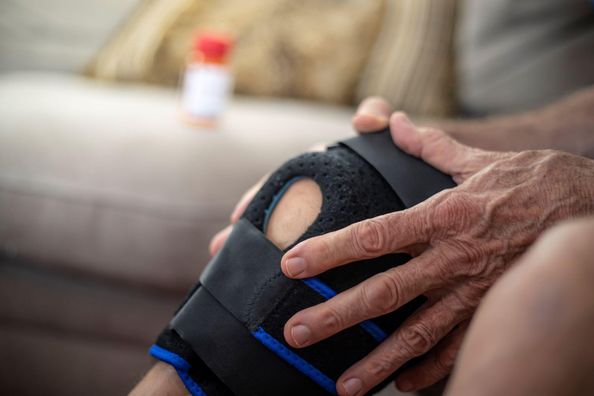When you hear the words “carpal tunnel syndrome,” your mind might immediately jump to wrist pain.
Carpal tunnel syndrome, or CTS, causes more than pain. It also causes numbness, weakness, and that “pins and needles” feeling. It’s extremely common – in fact, it’s one of the most common hand conditions.
New to CTS? Here are answers to common questions about the condition.
What Exactly Is Carpal Tunnel Syndrome?
The carpal tunnel is a narrow passageway in your wrist on the palm side of your hand. It’s made of tendons, ligaments, and bones.
One of the main things that passes through the carpal tunnel is the median nerve. This is a nerve that helps you move your forearm, wrist, hand, thumb, and three middle fingers. It also sends sensations (like touch, temperature, and pain) from your hand and lower arm to your brain.
CTS is when there is too much pressure on the median nerve, which happens when the nerve gets irritated, compressed, or squeezed as it passes through the tunnel.

If you think you have carpal tunnel syndrome, call to schedule an appointment with a South Bend Clinic orthopedic specialist. For qualifying patients, Dr. Akre can perform a carpal tunnel release right in the office using local anesthesia at either the South Bend or Granger location. No hospital visit required, and you can drive yourself home the same day.
What Does CTS Feel Like?
Symptoms of CTS usually begin gradually, rather than after an injury. They may come and go in the early stages, but they tend to happen more frequently and for longer periods of time as CTS gets worse.
The telltale signs of CTS are tingling, numbness, and pain in the wrist, hand, or fingers (especially at your fingertips). This can feel like an electric shock in your fingers and can wake you up in the middle of the night. Sometimes, the sensation travels up to your arm.
One of the other main symptoms of CTS is weakness and clumsiness in your hand. It might make it difficult to do fine movements (like buttoning a shirt or writing) or cause you to constantly drop things.
Read on Duly Health and Care: Is Clumsiness a Sign of a Health Problem?
What Causes CTS?
Anything that puts extra pressure on your median nerve can cause CTS. The pressure often happens when one part of your wrist is damaged or swollen and it pushes on the tissue and median nerve around it.
For example, if you break your wrist, the carpal tunnel can become narrower. The median nerve has less space to pass through, so it can have more pressure put on it and become irritated.
There can be multiple factors causing CTS. In others, it’s not clear what caused CTS to develop. Either way, it’s not always easy to pinpoint a single cause of CTS.
What Makes Someone More at Risk for CTS?
Several risk factors are linked with CTS, even if they don’t directly cause it. Risk factors include:
- A naturally small carpal tunnel (which tends to run in families)
- Conditions that can cause median nerve damage, like diabetes
- Inflammatory conditions, like rheumatoid arthritis and gout, that cause swelling and put pressure on the median nerve
- Constantly doing repetitive motions with your hands or wrists, like swinging a hammer
- Repeatedly using vibrating machinery or tools
- Pregnancy
- Obesity
- Trauma to the wrist
- Older age
- Being assigned female at birth
Can Frequent Typing Cause CTS?
It’s possible for heavy computer usage and typing to increase your risk for CTS, but it’s never been proven to be a direct cause. That said, it’s important to pay attention to your computer use habits. Using an incorrectly-positioned keyboard or mouse can cause other types of wrist pain.
When typing, make sure to:
- Arrange your keyboard and mouse for your body size and height to avoid overworking your wrists.
- Keep your wrists and forearms neutral or almost straight to reduce strain on the wrists.
- Take breaks to move and stretch.
- Try to switch between sitting and standing as you work, since this strengthens tendons and loosens joints.
Read on Duly Health and Care: Upgrading your Work-From-Home Space
Will I Need Surgery for CTS?
There are many ways to treat CTS, and the most common ones are nonsurgical. Examples include:
- Wearing a splint (usually while you sleep). The splint holds your wrist in place in a neutral position, keeping pressure off the median nerve.
- Doing certain exercises that strengthen and stretch your wrist and increase flexibility. You may benefit from doing exercises with a physical or occupational therapist.
- Making adjustments to your posture or work environment. You may need to tweak how you stand, sit, or position your keyboard.
- Getting corticosteroid injections. These are prescription anti-inflammatory medications that decrease pressure on the median nerve and relieve pain.
For short-term pain relief, your provider may recommend over-the-counter medications, like acetaminophen (Tylenol®) or ibuprofen (e.g., Advil®, Motrin®). However, you shouldn’t take these medications more than 10 days in a row without talking to your provider.
What Happens If I Need Carpal Tunnel Surgery?
If CTS symptoms are severe or aren’t getting better with nonsurgical treatments, it may be time for carpal tunnel release surgery.
During carpal tunnel release, your surgeon will cut the ligament that connects your wrist and palm. This creates more space inside your wrist and reduces tension on the carpal tunnel. The surgery can be open or endoscopic.
Carpal tunnel release is usually outpatient, so you can go home the same day of the surgery. The surgery can often be done with local anesthesia (medication that temporarily blocks pain in a small area of the body) or light sedation, rather than general anesthesia (medication that puts you in a sleep-like state).
Also read: What Does General Anesthesia Mean?
While it can take several months to fully heal from surgery, most people can go back to their daily activities within a few days. However, your provider may recommend waiting four to six weeks before returning to more strenuous activities, like sports or intense workouts.
I Think I Have CTS, But It’s Not That Bad. Do I Still Need to See a Doctor?
Even if your symptoms aren’t that bothersome, it’s best to get medical care sooner rather than later. CTS gets worse over time, and it’s harder to manage in its later stages. You’re less likely to need surgery if you get it taken care of early on. Also, the irritation in your wrist can cause permanent damage if it remains untreated.
Whether your symptoms are just starting or they’ve become severe, CTS can be a frustrating condition. But with the right treatment, most people can find relief. Call today to schedule your carpal tunnel evaluation with an orthopedic specialist.





